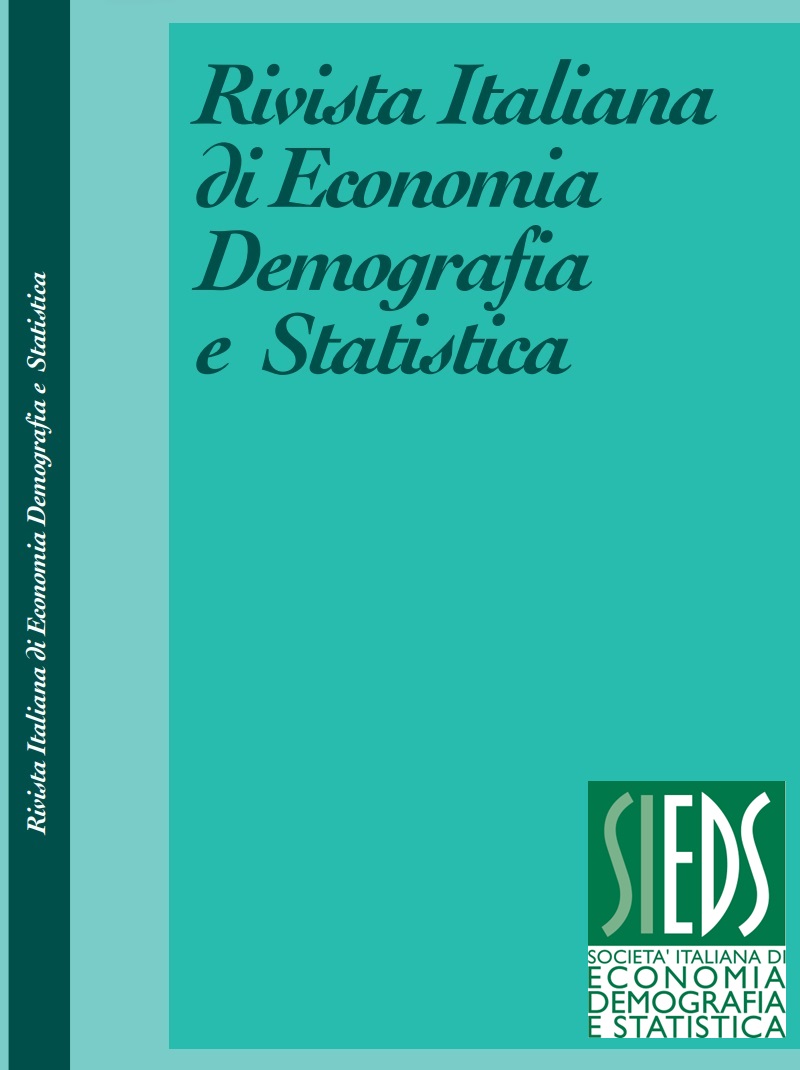Residential concentration of non-national population subgroups and potential socioeconomic vulnerability in a southern Italian urban context
DOI:
https://doi.org/10.71014/sieds.v78i3.303Abstract
The spatial distribution of residential patterns has often been translated into profound and increasing segmentation of urban contexts, which frequently uncovered deep socioeconomic spatial inequalities. With modern cities as one of the main systems of stratification and fragmentation, the main aim of this article is to investigate the potential socioeconomic vulnerability and the spatial concentration of non-nationals in the city of Bari at the time of the last Census (2021) applying spatial methods to census trats as units of analyses and considering the top five foreign-nationality population subgroups there residing (Georgians, Bangladeshis, Albanians, Romanians and Chinese). Our results show that suburban areas in the city where the potential socioeconomic vulnerability is higher are not necessarily those in which groups non-nationals are over-represented, but interesting differences regarding specific groups of non-nationals emerge. Also, the territorial concentration of non-nationals respect to Italian residents tend to diverge not only across the space but also among subgroups of non-nationals. These findings might be relevant to inform knowledge-based policies dealing with the urban space, particularly those dealing with the distribution of socioeconomic vulnerability and ethnic concentration within and across the neighborhoods of the city.
References
ANDERSEN H. T., VAN KEMPEN R. 2003. New trends in urban policies in Europe: evidence from the Netherlands and Denmark. Cities, Vol. 20, No.2, pp. 77-86. DOI: https://doi.org/10.1016/S0264-2751(02)00116-6
BENASSI F., IGLESIAS-PASCUAL R. 2023. Local-scale residential concentration and income inequalities of the main foreign-born population groups in the Spanish urban space. Reaffirming the model of a divided city, Journal of Ethnic and Migration Studies, Vol. 49 , No.3, pp. 673-696. DOI: https://doi.org/10.1080/1369183X.2022.2067137
BENASSI F., NACCARATO A., IGLESIAS‐PASCUAL R., SALVATI L., STROZZA S. 2022. Measuring residential segregation in multi‐ethnic and unequal European cities. International Migration, Vol. 61, No. 2, pp. 341-361. DOI: https://doi.org/10.1111/imig.13018
BENASSI F., IGLESIAS-PASCUAL R., SALVATI L. 2020. Residential segregation and social diversification: exploring spatial settlement patterns of foreign population in Southern European cities. Habitat International, Vol. 101: 102200. DOI: https://doi.org/10.1016/j.habitatint.2020.102200
BOLT G. VAN KEMPEN R., VAN HAM M. 2008. Minority Ethnic Groups in the Dutch Housing Market: Spatial Segregation, Relocation Dynamics and Housing Policy. Urban Studies, Vol. 45. DOI: https://doi.org/10.1177/0042098008090678
CARELLA M., GARCÍA-PEREIRO T., PATERNO A. 2024. Socioeconomic distress and foreign presence in a Southern urban context. The case of Bari. In: POLLICE A. & MARIANI P. (Eds) Methodological and Applied Statistics and Demography I, SIS 2024, Short Papers, Conference proceedings, Springer.
CARMO R. M. D., CARVALHO M. 2013. Multiple disparities: Earning inequalities in Lisbon. Landscape and Geodiversity, Vol. 1, pp. 36-45.
CASTELLS M., MOLLENKOPF J. H., 1991. Dual City: Restructuring New York, New York, Russell Sage Foundation.
DREIER P., MOLLENKOPF J., SWANSTROM T. 2001. Place Matters: Metropolitics for the Twenty First Century. Lawrence: University Press of Kansas.
FAINSTEIN S., GORDON I., HARLOE M. 1992. Divided cities, Cambridge, Blackwell.
GALSTER G., SHARKEY P. 2017. Spatial foundations of inequality: A conceptual model and empirical overview. RSF: The Russell Sage Foundation Journal of the Social Sciences, Vol. 3, No. 2, pp. 1-33. DOI: https://doi.org/10.7758/rsf.2017.3.2.01
IMERAJ L., FINNEY N., GADEYNE S. 2020. Demographic Dynamics Across Urban Settings and Implications for Ethnic Geographies. Population Space and Place. Article 2391. DOI: https://doi.org/10.1002/psp.2391
LECLERC C. 2021. Immigrants’ Earnings and Neighbourhood Economic Wealth: The Conditioning Role of Citizenship. Journal of Ethnic and Migration Studies. DOI: https://doi.org/10.1080/1369183X.2021.1971958
LYMPEROPOULOU K., FINNEY N. 2017. Socio-spatial factors associated with ethnic inequalities in districts of England and Wales, 2001–2011. Urban Studies, Vol. 54, No.11, pp. 2540–2560. DOI: https://doi.org/10.1177/0042098016653725
MALOUTAS T., SPYRELLIS S.N. 2019. Segregation trends in Athens: the changing residential distribution of occupational categories during the 2000s, Regional Studies, Vol. 54, No.4, pp. 462-471. DOI: https://doi.org/10.1080/00343404.2018.1556392
MARCIŃCZAK S., MOOSES V., STRÖMGREN M., TAMMARU, T. 2021. A comparative study of immigrant-native segregation at multiple spatial scales in urban Europe. Journal of Ethnic and Migration Studies, pp. 1–23. DOI: https://doi.org/10.1080/1369183X.2021.2008887
MOLLENKOPF J. H., CASTELLS, M. (Eds.). 1991. Dual City: Restructuring New York. Russell Sage Foundation.
MUSTERD S. 2005. Social and ethnic segregation in Europe: levels, causes, and effects. Journal of Urban Affairs, Vol. 27, pp. 331-348. DOI: https://doi.org/10.1111/j.0735-2166.2005.00239.x
MUSTERD S., OSTENDORF W. 2012. Inequalities in European Cities, Amsterdam: Elsevier. DOI: https://doi.org/10.1016/B978-0-08-047163-1.00677-9
OBERTI M., PRÉTECEILLE E. 2004. Les classes moyennes et la ségrégation urbaine. Éducation et sociétés, 14(2), 135-153. DOI: https://doi.org/10.3917/es.014.0135
OECD. 2018. Divided Cities: Understanding Intra-urban Inequalities. Paris: OECD Publishing.
PORTES A., RUMBAUT R. G. 2006. Immigrant America: A Portrait. Berkeley: University of California Press. DOI: https://doi.org/10.1525/9780520940482
PISAREVSKAYA A., SCHOLTEN P., KAŞLI, Z. 2021. Classifying the diversity of urban diversities: an inductive analysis of European cities. Journal of International Migration and Integration, Vol. 23, pp. 655–677. DOI: https://doi.org/10.1007/s12134-021-00851-z
REARDON S.F., O’SULLIVAN D. 2004. Measures of Spatial Segregation. Sociological Methodology, Vol. 34, 121–162. DOI: https://doi.org/10.1111/j.0081-1750.2004.00150.x
TAMMARU T., MARCIŃCZAK S., VAN HAM M., MUSTERED, S. 2016. Socio-economic segregation in European capital cities. East meets West. London: Routledge. DOI: https://doi.org/10.4324/9781315758879
TAMMARU T., MARCINCZAK S., AUNAP R., VAN HAM M., JANSSEN H.. 2020. Relationship Between Income Inequality and Residential Segregation of Socioeconomic Groups. Regional Studies, Vol. 54 , No.4, pp. 450–461. DOI: https://doi.org/10.1080/00343404.2018.1540035
VAN KEMPEN R. 2005. Segregation and housing conditions of immigrants in Western European cities. In: Y. KAZEPOV (Ed.) Cities of Europe: Changing Contexts, Local Arrangements, and the Challenge to Urban Cohesion, pp. 190-209. Oxford: Blackwell. DOI: https://doi.org/10.1002/9780470694046.ch9
VAN KEMPEN R. 2007. Divided cities in the 21st century: challenging the importance of globalisation. Journal of Housing and the Built Environment, Vol. 22, pp. 13-31. DOI: https://doi.org/10.1007/s10901-006-9064-3
YAO J., WONG D. W., BAILEY N., MINTON J. 2019. Spatial Segregation Measures: A Methodological Review. Tijdschrift voor Economische en Sociale Geografie, Vol. 110, pp. 235–250. DOI: https://doi.org/10.1111/tesg.12305
Downloads
Published
Issue
Section
License
Copyright (c) 2024 Maria Carella, Thaís Garcia Pereiro, Anna Paterno

This work is licensed under a Creative Commons Attribution 4.0 International License.



